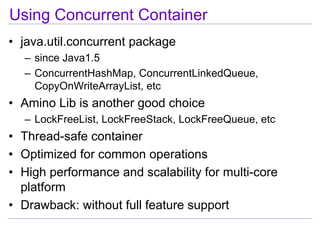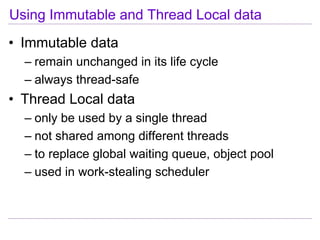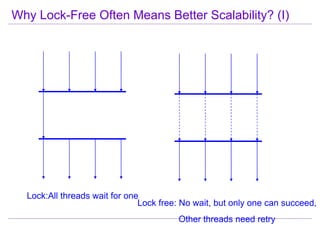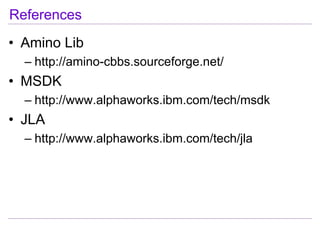Highly Scalable Java Programming for Multi-Core System
- 1. Highly Scalable Java Programming for Multi-Core System Zhi Gan ([email protected]) http://ganzhi.blogspot.com
- 2. Agenda • Software Challenges • Profiling Tools Introduction • Best Practice for Java Programming • Rocket Science: Lock-Free Programming 2
- 3. Software challenges • Parallelism – Larger threads per system = more parallelism needed to achieve high utilization – Thread-to-thread affinity (shared code and/or data) • Memory management – Sharing of cache and memory bandwidth across more threads = greater need for memory efficiency – Thread-to-memory affinity (execute thread closest to associated data) • Storage management – Allocate data across DRAM, Disk & Flash according to access frequency and patterns 3
- 5. The 1st Step: Profiling Parallel Application
- 6. Important Profiling Tools • Java Lock Monitor (JLM) – understand the usage of locks in their applications – similar tool: Java Lock Analyzer (JLA) • Multi-core SDK (MSDK) – in-depth analysis of the complete execution stack • AIX Performance Tools – Simple Performance Lock Analysis Tool (SPLAT) – XProfiler – prof, tprof and gprof
- 7. Tprof and VPA tool
- 8. Java Lock Monitor • %MISS : 100 * SLOW / NONREC • GETS : Lock Entries • NONREC : Non Recursive Gets • SLOW : Non Recursives that Wait • REC : Recursive Gets • TIER2 : SMP: Total try-enter spin loop cnt (middle for 3 tier) • TIER3 : SMP: Total yield spin loop cnt (outer for 3 tier) • %UTIL : 100 * Hold-Time / Total-Time • AVER-HTM : Hold-Time / NONREC
- 9. Multi-core SDK Dead Lock View Synchronization View
- 10. Best Practice for High Scalable Java Programming
- 11. What Is Lock Contention? From JLM tool website
- 12. Lock Operation Itself Is Expensive • CAS operations are predominantly used for locking • it takes up a big part of the execution time
- 13. Reduce Locking Scope public synchronized void foo1(int k) public void foo2(int k) { { String key = String key = Integer.toString(k); Integer.toString(k); String value = key+"value"; String value = key+"value"; if (null == key){ if (null == key){ return ; return ; }else { }else{ maph.put(key, value); synchronized(this){ } maph.put(key, value); } } } } 25% Execution Time: 16106 Execution Time: 12157 milliseconds milliseconds
- 14. Results from JLM report Reduced AVER_HTM
- 15. Lock Splitting public synchronized void public void addUser2(String u){ addUser1(String u) { synchronized(users){ users.add(u); users.add(u); } } } public void addQuery2(String q){ public synchronized void synchronized(queries){ addQuery1(String q) { queries.add(q); queries.add(q); } } } Execution Time: 12981 Execution Time: 4797 milliseconds milliseconds 64%
- 16. Result from JLM report Reduced lock tries
- 17. Lock Striping public synchronized void public void put2(int indx, put1(int indx, String k) { String k) { share[indx] = k; synchronized } (locks[indx%N_LOCKS]) { share[indx] = k; } } Execution Time: 5536 Execution Time: 1857 milliseconds milliseconds 66%
- 18. Result from JLM report More locks with less AVER_HTM
- 19. Split Hot Points : Scalable Counter – ConcurrentHashMap maintains a independent counter for each segment of hash map, and use a lock for each counter – get global counter by sum all independent counters
- 20. Alternatives of Exclusive Lock • Duplicate shared resource if possible • Atomic variables – counter, sequential number generator, head pointer of linked-list • Concurrent container – java.util.concurrent package, Amino lib • Read-Write Lock – java.util.concurrent.locks.ReadWriteLock
- 21. Example of AtomicLongArray public synchronized void set1(int private final AtomicLongArray a; idx, long val) { d[idx] = val; public void set2(int idx, long val) { } a.addAndGet(idx, val); } public synchronized long get1(int public long get2(int idx) { idx) { long ret = a.get(idx); return ret; long ret = d[idx]; } return ret; } Execution Time: 23550 Execution Time: 842 milliseconds milliseconds 96%
- 22. Using Concurrent Container • java.util.concurrent package – since Java1.5 – ConcurrentHashMap, ConcurrentLinkedQueue, CopyOnWriteArrayList, etc • Amino Lib is another good choice – LockFreeList, LockFreeStack, LockFreeQueue, etc • Thread-safe container • Optimized for common operations • High performance and scalability for multi-core platform • Drawback: without full feature support
- 23. Using Immutable and Thread Local data • Immutable data – remain unchanged in its life cycle – always thread-safe • Thread Local data – only be used by a single thread – not shared among different threads – to replace global waiting queue, object pool – used in work-stealing scheduler
- 24. Reduce Memory Allocation • JVM: Two level of memory allocation – firstly from thread-local buffer – then from global buffer • Thread-local buffer will be exhausted quickly if frequency of allocation is high • ThreadLocal class may be helpful if temporary object is needed in a loop
- 25. Rocket Science: Lock-Free Programming
- 26. Using Lock-Free/Wait-Free Algorithm • Lock-Free allow concurrent updates of shared data structures without using any locking mechanisms – solves some of the basic problems associated with using locks in the code – helps create algorithms that show good scalability • Highly scalable and efficient • Amino Lib
- 27. Why Lock-Free Often Means Better Scalability? (I) Lock:All threads wait for one Lock free: No wait, but only one can succeed, Other threads need retry
- 28. Why Lock-Free Often Means Better Scalability? (II) X X Lock:All threads wait for one Lock free: No wait, but only one can succeed, Other threads often need to retry
- 29. Performance of A Lock-Free Stack Picture from: http://www.infoq.com/articles/scalable-java-components
- 30. References • Amino Lib – http://amino-cbbs.sourceforge.net/ • MSDK – http://www.alphaworks.ibm.com/tech/msdk • JLA – http://www.alphaworks.ibm.com/tech/jla
- 31. Backup
Editor's Notes
- #6: What if all previous best prestise cannot meet your need? You would like to optimize your application manually?
- #7: msdk – This tool can be used to do detailed performance analysis of concurrent Java applications. It does an in-depth analysis of the complete execution stack, starting from the hardware to the application layer. Information is gathered from all four layers of the stack – hardware, operating system, jvm and application.
- #8: `
- #28: For multi-thread application, lock-free approach is different with lock-based approach in several aspects: When accessing shared resource, lock-based approach will only allow one thread to enter critical section and others will wait for it On the contrary, lock-free approach will all every thread to modify state of shared state. But one of the all threads can succeed, and all other threads will be aware of their action are failed so they will retry or choose other actions.
- #29: The real difference occurs when something bad happens to the running thread. If a running thread is paused by OS scheduler, different thing will happen to the two approach: Lock-based approach: All other threads are waiting for this thread, and no one can make progress Lock-free approach: Other threads will be free to do any operations. And the paused thread might fail its current operation From this difference, we can found in multi-core environment, lock-free will have more advantage. It will have better scalability since threads don’t wait for each other. And it will waste some CPU cycles if contention. But this won’t be a problem for most cases since we have more than enough CPU resource






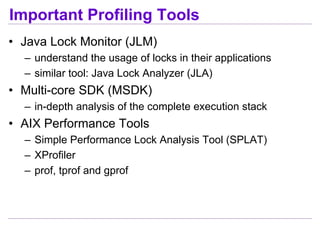








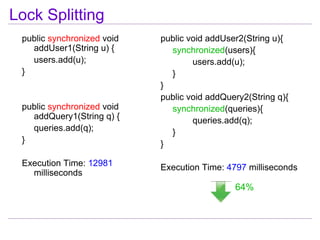
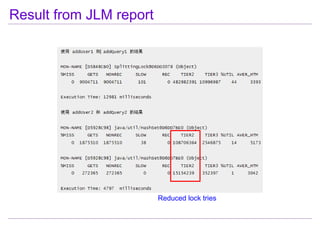
![Lock Striping
public synchronized void public void put2(int indx,
put1(int indx, String k) { String k) {
share[indx] = k; synchronized
} (locks[indx%N_LOCKS]) {
share[indx] = k;
}
}
Execution Time: 5536 Execution Time: 1857
milliseconds milliseconds
66%](https://image.slidesharecdn.com/hsjavaopenparty1-100828093729-phpapp01/85/Highly-Scalable-Java-Programming-for-Multi-Core-System-17-320.jpg)



![Example of AtomicLongArray
public synchronized void set1(int private final AtomicLongArray a;
idx, long val) {
d[idx] = val; public void set2(int idx, long val) {
} a.addAndGet(idx, val);
}
public synchronized long get1(int public long get2(int idx) {
idx) { long ret = a.get(idx); return ret;
long ret = d[idx]; }
return ret;
}
Execution Time: 23550 Execution Time: 842 milliseconds
milliseconds
96%](https://image.slidesharecdn.com/hsjavaopenparty1-100828093729-phpapp01/85/Highly-Scalable-Java-Programming-for-Multi-Core-System-21-320.jpg)
